CEATEC Japan, Part 1

So I visited CEATEC Japan last Friday. I thought that maybe I could get a look at some of the upcoming technology and bring back the goods to my Introduction to Computers class. But while there was some fun stuff, it didn’t really knock my socks off–there was lots of stuff I know is in the works which was not shown, a lot of the in-development stuff they did show was pretty tame, and most of the stuff was just current for-sale technology that people were trying to sell. Well, it’s a trade show, so that’s par for the course; I just thought there would be more ground-breaking stuff to be found.
I attended a panel discussion during the afternoon which I thought looked promising: titled “Personal Computing Will Undergo a Transformation!” it included high-level executives from Intel, NEC, Sony, Panasonic, Fujitsu, and Microsoft. It sounded like they were really going to get into a lot of the cool stuff coming up, maybe discuss how the user experience will dramatically change in the next five to ten years. Well, not so much. Each panel member took about 10 minutes to essentially present an infomercial for their company, then there were a few rather plain-vanilla questions (“How will that spiffy new Windows 7 change things?”), and not much else. There were very quick mentions of stuff like 3-D interactivity–but most of it was about stuff that’s pretty pedestrian, like cloud connectivity. Overall, a pretty disappointing show. I’m not sure if I even benefitted by the simultaneous translation–without it, I might have thought it was much cooler.
Anyway, here are some of the photos I took of a few of the more interesting things to see.

This is an as-yet uncompleted project KDDI was showing off–a mini-robot pod which acts as a moving, motion-sensitive stand for your cell phone. It has built-in speakers, automatically closes or opens up (triggered by what I didn’t find out), and can roll about and do turns, presumably to face and be accessible to the user. It is also supposed to be able to interface with your TV or LCD, showing the cell phone’s data on whatever display you choose. Cool concept.

Nearby, they were demo’ing a cell phone with virtual overlays of data on what the phone’s camera displayed; in this case, when they pointed the phone (presumably outfitted with an electronic compass) in a certain direction, it would tell you what interesting stuff exists in that direction, with images of each point appearing in frames. Not revolutionary–this kind of stuff is being played around with on iPhone and Android phones–but still an interesting concept which will undoubtedly be smoothed out and will be quite useful in the future.

Some stuff was simply for show, like themed notebook cases (this was at the Intel booth, for some reason). Below are a netbook with a reversible monitor, and a smartphone with full-face display.
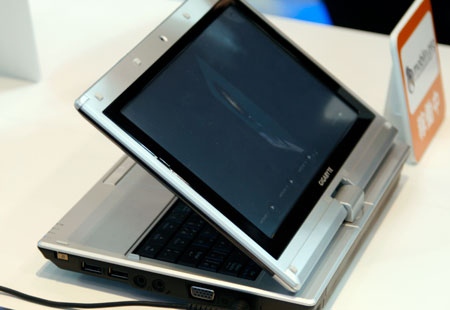
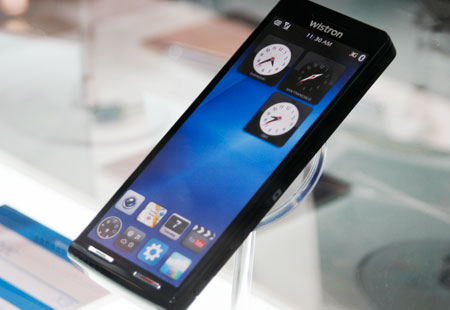
They had a lot of touchscreens there, but nothing knocked my socks off. The only ones I found were not multi-touch–it was nothing more than a trackpad could do, and not all that impressive.
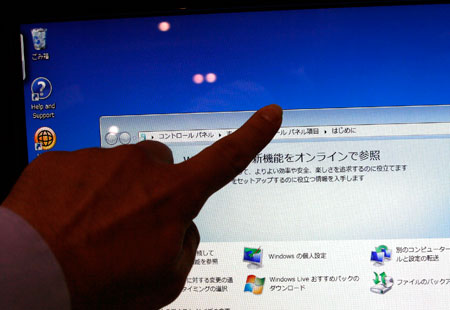
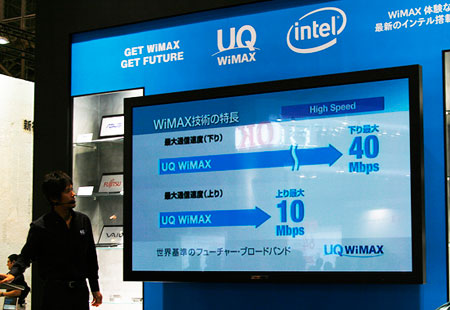
One thing that surprised me: Tokyo has WiMAX, and has since July. I guess I didn’t get the memo. If you don’t know what WiMAX is, it’s a new-ish wireless Internet service. It’s kind of like WiFi, except it’s wide-area; the entire city is a hotspot. Think of it like 3G, except it’s a lot faster. Effectively, it’s an Internet connection that follows you wherever you go. Instead of getting broadband just at home, you get it everywhere you take your computer–except, presumably, in basement coffee shops or other areas where cell phone reception might also be spotty.
Tokyo’s service boasts 40 Mbps download, 10 Mbps upload, though such claims are always over-rated–I’m supposed to have 100 Mbps fiber-optic at home, but have never gotten anywhere near that speed. So figure that Tokyo’s WiMAX is at least a fair-speed broadband connection.
The catch: it’s expensive. They charge 4,480 yen (about $50) per month to subscribe; that’s not too bad, I pay about that much for fiber. The problem is, they don’t give you the reception devices for free. If your laptop does not have built-in WiMAX (few do), then each laptop will have to have a $140 USB dongle. For home networks, a reception base that will distribute the connection to home devices costs about $170. To set Sachi and myself up with this, we’d have to shell out $450. No thanks on that; I’m OK as-is. They do have a free 15-day trial they offer, and I may take them up on that just to test out the system.
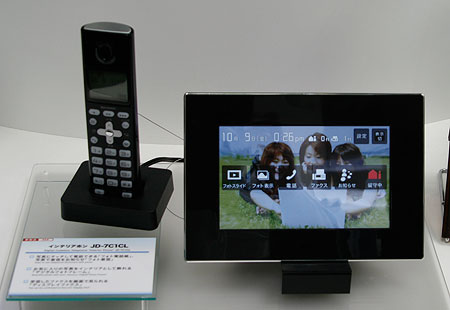
This was a nice little gadget: a video phone which doubles as a photo frame. Probably has features I didn’t sniff out while there.
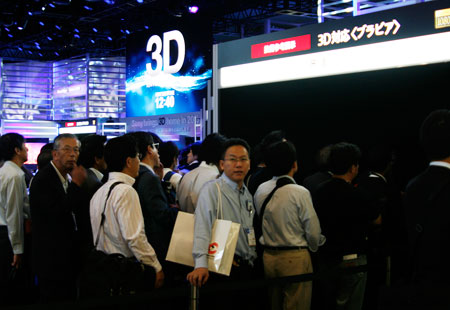
The first of three large halls at Makuhari was dedicated mostly to the big home electronics firms, and it seems that every one of them had a 3-D HDTV system. They also had most of their good stuff inside the booths, all of which had long lines. I didn’t have enough time–the lines looked like they were about an hour long each. I figured I’d simply take their word for it.

This was a neat little gadget: a hand-held laser projector, which will take lots of inputs, including the iPhone shown here. For $500, this iPhone-sized dealio will project an image onto any surface you point it at–great for impromptu slide shows, when a TV or other projector is not available. The image was a bit weak, best in dark rooms or close-up. The American guys pitching it said that in a dark room, it was possible to use it as a “100-inch TV screen.” Uh, maybe. They said they can’t sell it in Japan yet, because the government made laser projectors illegal after some bad laser pointer incidents years back, and haven’t updated the legislation yet. This looks like a nice toy, but I couldn’t possibly justify buying one. Still, this is something I expect will shrink in size and price over the years and may eventually become a standard feature in hand-held devices.
Before I finish for today’s post, one more–this gadget being one that I frankly pray to god will never become popular. I show it here as a screen shot from the manufacturer’s web site: a wearable speaker vest.

Yes, that’s right. If you think it’s bad when a-holes outfit their cars with giant speaker systems so the entire county can be massively annoyed by their poor taste in music, then you’ll love this. The user just plugs in their digital audio device, and the music gets blasted out of speakers on the shoulders. And it’s loud, too–they guy demonstrated it for me. It is designed for joggers, bicyclists, and motorcyclists–yes, it is intended to be loud enough to be heard clearly when wearing a full-head helmet, over engine noise. He said it was for people who could be endangered by using headsets because they can’t hear traffic coming. So instead, they blast the music for everyone in the area to hear–and they still can’t hear traffic coming. But now everybody is getting pissed off to boot. Whee!
The rest tomorrow.
